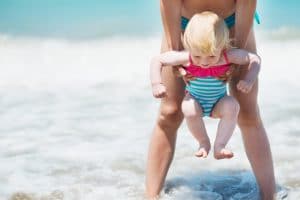
Although they are terribly scary to witness, they are not necessarily a sign of serious infection (in fact they are often associated with run-of-the-mill viral infections) and don’t cause brain damage or long term effects. Most do not require any special follow up apart from determining (and treating if necessary) the source of the fever.
Main features of a febrile convulsion
The main feature of a febrile convulsion is fever (although it may not have been noticed prior to the seizure). The child will loose consciousness, their eyes often roll back, and they may stiffen and have jerky rhythmic arm and leg movements. They may go blue. Febrile convulsions usually only last seconds to minutes, but they almost always seem a lot longer.
What to do
The most important thing to do if this happens is stay calm and ensure the child is safe, which includes;
- Ensuring they are somewhere safe with no objects nearby that may cause injury (e.g. sharp edges on furniture, glass)
- Don’t shake or slap them to wake them up
- Don’t try to restrain them
- Don’t put anything in their mouth
- Once they stop jerking, roll them onto their left side to allow them to recover
- Call an ambulance if you are worried (particularly if it is their first seizure) or if the seizure lasts over 5 minutes.
If you think of it (and often in the panic you don’t so don’t stress if you forget) look at a clock so you know approximately how long the seizure lasted and make note of what happened or video a bit on your phone. This can help the doctor confirm the diagnosis of simple febrile convulsion.
If you did not feel the need to call an ambulance, once your child has recovered, get them seen by a doctor promptly. The main purpose of doing this is to determine the source of the fever. Often the cause is a viral infection or ear infection but it is important to rule out more serious infections like meningitis.
Types of febrile convulsions
A “simple” febrile convulsion will not usually require follow-up investigation. The features of a simple febrile convulsion include;
- Less than 15 minutes
- Generalised tonic clonic seizure type (loss of consciousness and both sides of the body affected by jerky movements, not just one limb for example)
- Associated with fever
- Occur less than once in 24hours/with the same illness.
Complex febrile convulsions
A “complex” febrile convulsion will be followed up by a specialist pediatrician and may involve investigations (such as MRI scan of the brain and/or an EEG-a tracing of the brain waves). Both are safe and pain free tests, often done as an outpatient. Features that make a febrile convulsion “complex” include;
- Lasting over 15 minutes
- Recurring more than once in the same illness/more than one seizure in 24hrs
- Not recovered within an hour
- Focal features (e.g. just one arm/one leg rather than generalized jerking).
Of the children who have a febrile convulsion, many will only have the one. However, if they are under one when they have their first, they have up to 50% chance of having another with another fever. By the age of three, the recurrence rate is probably about 20% with subsequent fevers. Interestingly, giving panadol or ibuprofen for fever does not actually reduce the risk of a child having a febrile convulsion (but is still worth doing for comfort if the child is miserable).
The risk of developing epilepsy with one simple febrile convulsion is about 1-2% (about the same as the general population risk). If there are risk factors for developing epilepsy (such as family history, developmental concerns or complex febrile convulsions) the risk may be higher. One risk factor gives about 2% chance of epilepsy and more than two possibly up to 10% chance.
So remember that although dramatic and scary to watch, if your child does ever suffer a febrile convulsion, you can be confident they are likely to fully recover with no long-term problems. The most important thing is ensuring their safety during/just after the convulsion and seeking medical attention to clarify the diagnosis/determine the cause of the fever.
Information source:
Royal Children’s Hospital Melbourne 2011. Febrile convulsions. Retrieved April 24, 2016, from http://www.rch.org.au/clinicalguide/guideline_index/Febrile_Convulsion/













